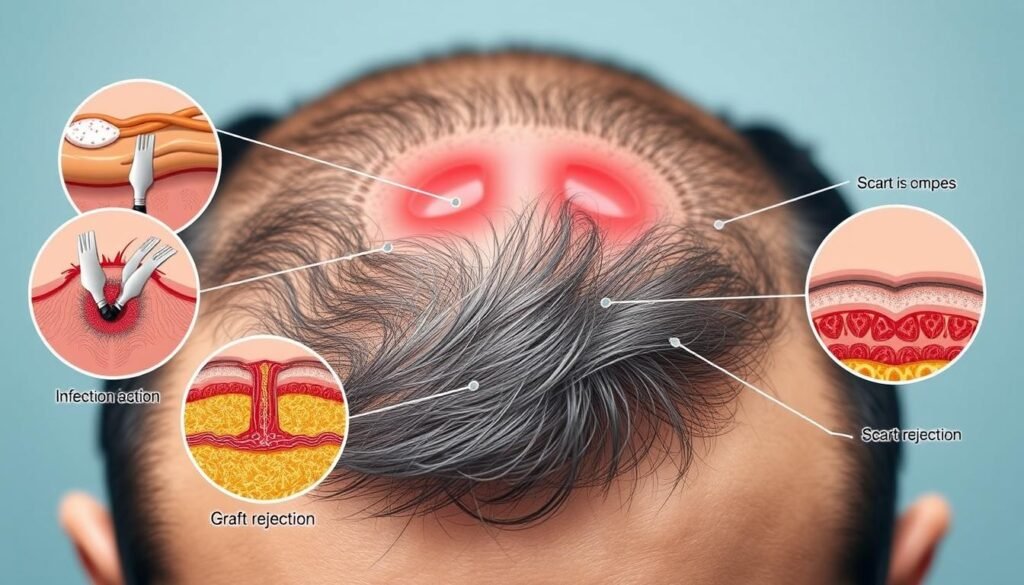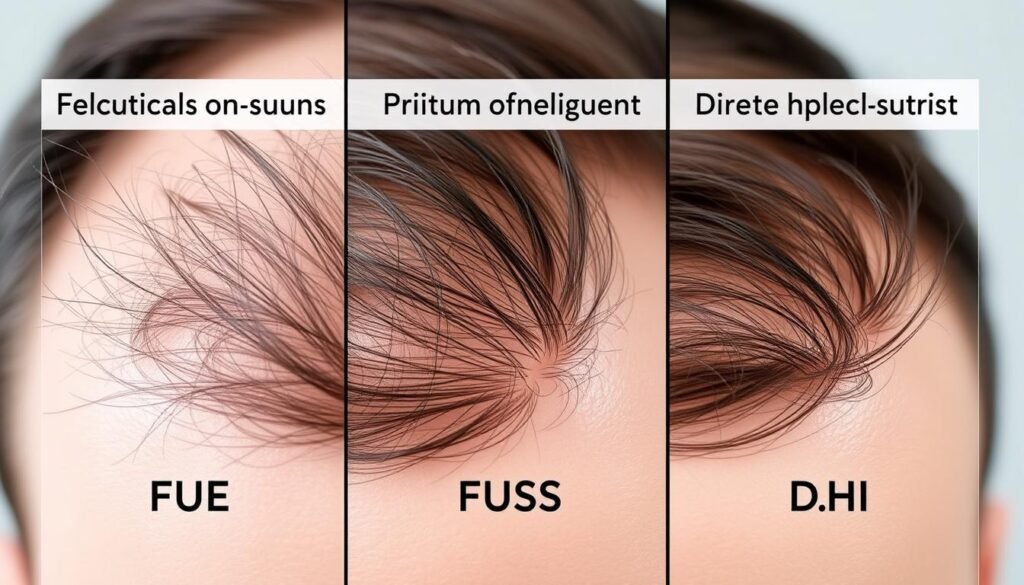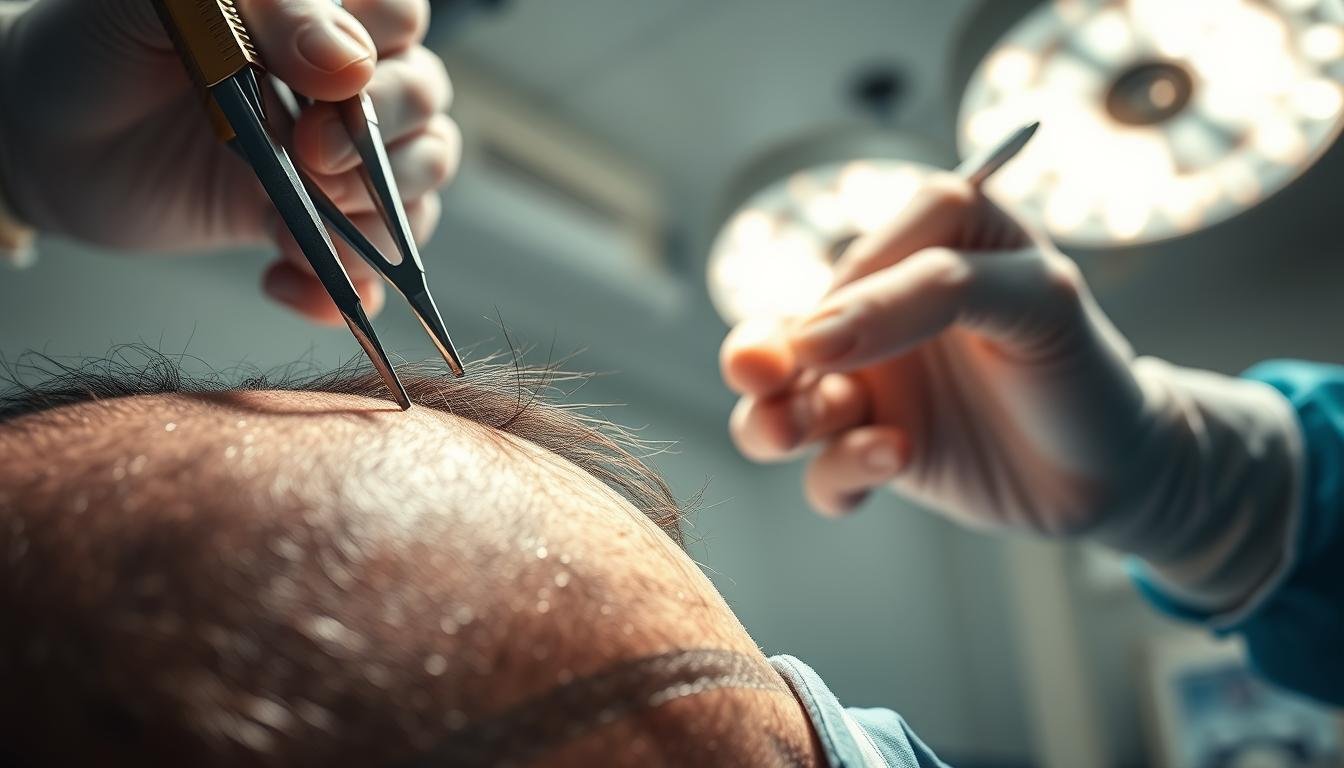For individuals experiencing hair loss, a hair transplant can be a life-changing solution. However, concerns about the safety of this surgical procedure are natural.
Over the years, hair transplant techniques have evolved significantly, becoming increasingly safer and more effective. When performed by a qualified, experienced surgeon, the risks associated with hair transplant surgery are minimized.
Understanding the safety profile of modern hair transplant procedures is crucial for making an informed decision. This includes being aware of the potential risks and the importance of proper patient selection and facility standards.
Key Takeaways
- Modern hair transplant techniques have improved significantly in terms of safety and effectiveness.
- A qualified, experienced surgeon is crucial for minimizing risks associated with hair transplant surgery.
- Proper patient selection and facility standards play a vital role in ensuring the safety of the procedure.
- Understanding the potential risks and benefits is essential for making an informed decision.
- Thorough research and consultation with qualified specialists are necessary before undergoing a hair transplant.
Understanding Hair Transplant Procedures
Hair transplant procedures have evolved significantly, providing effective solutions for those suffering from hair loss. This surgical technique involves relocating hair follicles from a donor area, typically the back of the head, to areas experiencing thinning or baldness.
What Is a Hair Transplant?
A hair transplant is a type of surgery that moves hair you already have to fill an area with thin or no hair. This procedure has been refined since its inception in the 1950s in the U.S., with modern techniques offering more natural-looking results.
Types of Hair Transplant Techniques
There are several techniques used in hair transplantation, including:
- Follicular Unit Strip Surgery (FUSS/FUT)
- Follicular Unit Extraction (FUE)
- Hair Stem Cell Transplantation (HST)
Follicular Unit Strip Surgery (FUSS/FUT)
In FUSS, a strip of scalp is removed and divided into tiny grafts. This method allows for the transplantation of a large number of grafts in a single session.
Follicular Unit Extraction (FUE)
FUE involves extracting individual follicles directly from the donor area using specialized tools.
Hair Stem Cell Transplantation (HST)
HST is an innovative approach focusing on preserving stem cells in the donor area to promote natural regrowth.
| Technique | Description | Key Features |
|---|---|---|
| FUSS/FUT | Strip of scalp removed and divided into grafts | Large number of grafts in one session |
| FUE | Individual follicles extracted directly | Minimally invasive, less scarring |
| HST | Preserves stem cells for natural regrowth | Innovative, promotes natural hair growth |
Is Hair Transplant Safe?

The overall safety of hair transplant procedures depends on several key factors. While hair transplant surgery is generally considered safe when performed by a qualified, experienced board-certified plastic surgeon, individual reactions and healing abilities can vary greatly.
Overall Safety Profile
Modern hair transplant techniques have made this cosmetic procedure relatively safe. Statistical data and medical consensus indicate that hair transplants performed under proper conditions have a low risk of complications. Most complications are minor and temporary, making hair transplant a relatively low-risk procedure compared to other surgical interventions.
Factors Affecting Safety
Several factors influence the safety of a hair transplant. These include the patient’s overall health, medical history, and adherence to pre and post-operative instructions. The quality of the clinical setting and equipment also plays a crucial role in ensuring safety outcomes.
Importance of Qualified Surgeons
The qualifications and experience of the surgeon are perhaps the most critical factors in ensuring a safe hair transplant procedure. A board-certified surgeon with specialization in hair restoration significantly reduces the risk of complications. Proper patient selection criteria and a thorough consultation process are also essential safety measures.
By choosing a reputable clinic with proper sterilization protocols and following instructions carefully, people can minimize risks associated with hair transplant surgery. Advances in techniques and technology continue to improve the safety profile of transplants.
Potential Risks and Complications
Understanding the potential risks and complications associated with hair transplant procedures is crucial for making an informed decision. While generally considered safe, hair transplant surgery, like any other surgical procedure, carries potential risks and complications.
Common Side Effects
Common side effects of hair transplant include temporary hair thinning, swelling, itching, and post-operative pain. These effects are typically temporary and manageable.
Temporary Hair Thinning
Temporary hair thinning, also known as “shock loss,” is a normal part of the process for many patients. Existing hair may shed before new growth appears, but this is usually temporary.
Swelling and Itching
Swelling around the forehead and eyes, as well as itching during the healing process, are common post-operative symptoms. These can be managed with medication and proper post-operative care.
Post-Operative Pain
Most patients experience minimal pain that can be managed with over-the-counter medications. Cosmetic enhancements and proper pain management strategies can help minimize discomfort.
Serious Complications
While rare, serious complications can occur. These include infection risks, scarring concerns, and nerve damage.
Infection Risks
Infection is a risk with any surgical procedure, including hair transplant. Prevention measures include following post-operative instructions carefully and keeping the scalp clean.
Scarring Concerns
Scarring patterns differ between FUT (Follicular Unit Transplantation) and FUE (Follicular Unit Extraction) techniques. Factors influencing scar visibility include the skill of the surgeon and post-operative care.
Nerve Damage
Nerve damage can result in numbness or tingling. In most cases, these effects are temporary, but in some instances, they can be permanent.

| Complication | FUT Technique | FUE Technique | Management |
|---|---|---|---|
| Infection | Low Risk | Low Risk | Antibiotics |
| Scarring | Moderate Risk | Low Risk | Proper Wound Care |
| Nerve Damage | Low Risk | Low Risk | Monitoring |
| Temporary Thinning | Common | Common | Time, Medication |
By understanding these potential risks and complications, individuals can better prepare themselves for hair transplant surgery and make informed decisions about their treatment.
Recovery Process After Hair Transplant
The recovery period following a hair transplant is a critical phase that requires careful attention to detail and adherence to post-procedure care instructions. After the surgery, your scalp may be very tender, and you may need to take pain medications for several days.

Immediate Post-Procedure Care
Your surgeon will have you wear bandages over your scalp for at least a day or two. They may also prescribe an antibiotic or an anti-inflammatory drug for you to take for several days. It’s essential to follow these instructions carefully to ensure proper healing and minimize the risk of complications.
First Week After Transplant
Most people are able to return to work 2-5 days after the operation. During the first week, it’s crucial to manage common symptoms such as swelling and discomfort. Your surgeon will provide guidance on how to sleep, wash your scalp, and manage bandages in the first 24-48 hours after surgery.
Long-Term Recovery Timeline
Within 2-3 weeks after surgery, the transplanted hair will fall out, but you should start to notice new hair growth within a few months. Most people will see 60% of new hair growth after 6-9 months. Understanding this timeline is vital for managing expectations and ensuring satisfaction with the procedure.
Signs of Normal vs. Abnormal Recovery
It’s essential to distinguish between normal recovery symptoms and signs that might indicate complications requiring medical attention. If you experience unusual symptoms such as severe pain, infection, or unexpected hair loss, you should contact your surgeon immediately.
By following the post-procedure care instructions and attending follow-up appointments with your surgeon, you can optimize the results of your hair transplant and enjoy a successful recovery.
Comparing Safety Between Different Techniques
When considering a hair transplant, understanding the safety profiles of different techniques is crucial. Hair transplantation has evolved significantly, offering various methods, each with its own safety considerations.
Safety Considerations in FUSS and FUE
The two most common hair transplant techniques are Follicular Unit Strip Surgery (FUSS) and Follicular Unit Extraction (FUE). FUSS involves removing a strip of hair-bearing skin from the donor area, which can result in a linear scar. The visibility of this scar depends on the patient’s hair style; those with longer hair can more easily conceal it. In contrast, FUE involves extracting individual follicular units directly from the donor area, leaving small, scattered scars that are generally less noticeable.
FUSS procedures typically require less time than FUE, but the latter offers more flexibility in terms of donor area selection. However, FUE carries a risk of follicular transection, where the hair follicle is damaged during extraction, potentially rendering it unusable for transplantation. A study published on the National Center for Biotechnology Information website discusses the nuances of these techniques and their outcomes.
Advantages of Modern Techniques
Modern hair transplant techniques have significantly improved safety and efficacy. Technological advancements have reduced complications and improved outcomes. For instance, the use of robotic systems in FUE has enhanced precision and minimized the risk of follicular transection.
Artificial Hair Transplants and Safety Concerns
Artificial hair transplants, which involve implanting synthetic fibers, were banned by the FDA in 1983 due to safety concerns. These concerns included infection, allergic reactions, and scarring. While there have been developments in synthetic hair fibers, their use remains limited due to past safety issues.

Ensuring the Best and Safest Results
Ensuring the best outcomes from a hair transplant involves a combination of choosing the right clinic, preparing properly for the procedure, and following post-procedure instructions diligently.
Choosing the Right Clinic and Surgeon
When selecting a hair transplant clinic, several factors should be considered to ensure the best possible results. These include the clinic’s accreditation, the qualifications and experience of the surgeons, and the clinic’s specialization in hair restoration.
| Factor | Description | Importance |
|---|---|---|
| Accreditation | Ensure the clinic is accredited by a recognized accrediting agency. | High |
| Surgeon Experience | Look for surgeons with extensive experience in hair transplantation. | High |
| Specialization | Choose a clinic that specializes in hair restoration. | High |
It’s also crucial to evaluate potential surgeons based on their board certification, specific training in hair transplantation, and before-and-after portfolios. Consulting with multiple specialists can provide valuable insights into their approaches and help you make an informed decision.
Pre-Procedure Preparation
Proper preparation before the hair transplant procedure is vital for minimizing risks and ensuring a smooth recovery. This includes avoiding certain medications, making necessary lifestyle adjustments, and undergoing required medical evaluations. Patients should disclose their full medical history and current medications to their surgeon to identify any potential risks.
Following Post-Procedure Instructions
Following the post-procedure instructions provided by your surgeon is critical for achieving the best results and minimizing the risk of complications. This includes preparing your home environment for recovery, arranging for necessary support during the initial healing period, and attending follow-up appointments.
By taking an active role in the hair transplant process and following these guidelines, patients can significantly enhance the safety and success of their procedure.
Conclusion: Making an Informed Decision
Hair transplant surgery, when performed by experienced professionals in a sterile environment, offers a relatively safe and effective means of addressing hair loss. As we’ve discussed, the overall safety profile of hair transplants is favorable, with manageable risks when proper protocols are followed.
To make an informed decision, it’s crucial to weigh the potential benefits against the risks, considering factors like the psychological impact of hair loss versus the financial cost and recovery process of the treatment. The cost of a hair transplant can range from $4,000 to $15,000, and most insurance plans do not cover it. However, for many, the restoration of a natural hairline and the boost in confidence are well worth the investment.
It’s also important to consider alternative treatments and the timing of your decision, including your age and the pattern of hair loss. Consulting with qualified medical professionals will provide personalized advice tailored to your circumstances. Advances in hair transplant technology continue to improve outcomes and safety, making it an increasingly viable option for those experiencing hair loss.
By doing thorough research and consulting with experts, you can make a well-informed decision that aligns with your needs and expectations.


